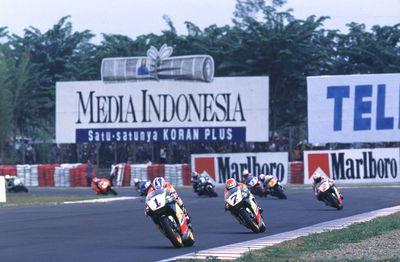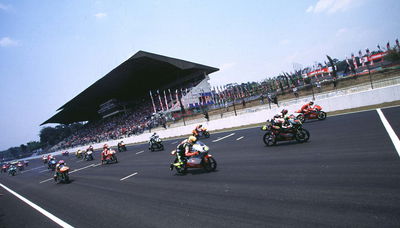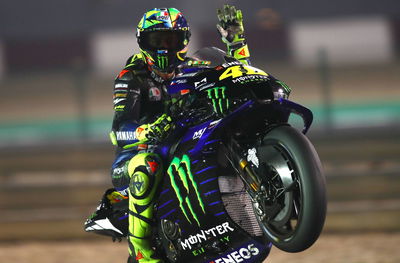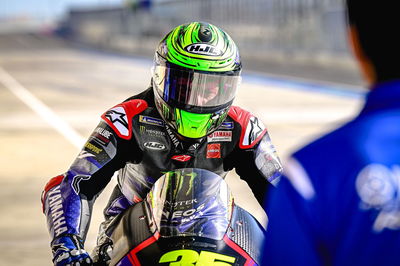The return of the Indonesian MotoGP
The Indonesian MotoGP comeback has been a long-held ambition for organisers and stakeholders in the sport, but the reality of putting on a race in one of the most bike-mad countries in the world has proven to be an almost impossible challenge.
The history of false starts for races in Indonesia is well documented and while neighbouring nations like Malaysia and most recently Thailand have found a happy home for motorsport, Indonesia continues to search through its many islands that make up the nation to find a suitable destination.

The Indonesian MotoGP comeback has been a long-held ambition for organisers and stakeholders in the sport, but the reality of putting on a race in one of the most bike-mad countries in the world has proven to be an almost impossible challenge.
The history of false starts for races in Indonesia is well documented and while neighbouring nations like Malaysia and most recently Thailand have found a happy home for motorsport, Indonesia continues to search through its many islands that make up the nation to find a suitable destination.
MotoGP has put on the Indonesian Grand Prix before, two to be precise, in 1996 and 1997.
With title sponsorship backing from Marlboro and headline-grabbing stars – Mick Doohan won the inaugural 500cc Grand Prix in 1996 and a year later a young Valentino Rossi won his final 125cc race on the way to his first world title – the Indonesian GP had a short but sweet history at the Sentul International Circuit.
For 1998, the Indonesian round was replaced by Argentina, officially at least, while underlying complaints about the circuit and organisation were often cited as the reasons the sport hasn’t returned in the past 20 years.
In the period since MotoGP left Sentul numerous plans have been plotted to ensure it returns to Indonesia but without success.
MotoGP saw a mooted return to Sentul fall through, when sufficient circuit upgrades didn’t come together, with the race set to take up a five-year deal starting in 2017.
Then followed reports of a new circuit designed by Hermann Tilke which was set to be built in Palembang, South Sumatra, with infrastructure developed to tie in with the 2018 Asian Games which would see the track be ready by 2019, but those plans quickly fell silent.
Now an ambitious project in Lombok is the latest attempt to bring back MotoGP, supported by the Indonesian government authorities which has seen an agreement put in place to construct a street-style circuit in the Mandalika tourist region with the first race set to take place in 2021.
The use of a street circuit for modern Grand Prix motorcycle racing raised eyebrows but following assurances from developers and computer-generated images the ‘street’ element appears to be a loose interpretation – more tourist resort roads than bustling city highways.

Instead, the circuit will be a permanent facility with the familiar safety run-off areas and gravel traps to meet FIM safety standards, but when it isn’t being used for racing the track will be used for public vehicles on the island.
“We are very conscious that when we announced this project there was a reasonable amount of scepticism about the concept of a street circuit,” Mark Hughes, MRK1 Consulting chief, explained in a presentation of the project at the 2019 Qatar Grand Prix.
“We have to make very clear that the track has been designed and will be built to the appropriate FIM safety standards for MotoGP.
“When you arrive for the race event it will be like arriving at any other MotoGP track. It will have all the infrastructure there.
“But a large percentage of that infrastructure would then come out in order to turn the track back into a road network for the resort for the rest of the year.
“I think that’s very important for Indonesia. Indonesia is such a widespread country that having a permanent circuit in Indonesia in one place didn’t necessarily make sense. But this is great use of the Mandalika resort.”
Hughes’s explanation hints at the biggest hurdles MotoGP has faced trying to return to Indonesia.
As one of quickest growing economies in South-East Asia and the biggest motorcycle market in the region, space for any new development comes at a premium across the country with housing, industrial estates and social enterprises taking the bulk of what is available with approval from the government.
This year Formula E faced roadblocks trying to organise its inaugural race in Jakarta, Indonesia’s capital city, with frequent amendments made to its temporary street circuit plans based around the National Monument in the centre of the city.
Ultimately, all preparations have been put on hold amid the coronavirus outbreak with the race postponed indefinitely from its early June slot.
For MotoGP’s Lombok plans it has a little more time to play with, with its race deal starting in 2021, but concerns have already risen on the progress of the site construction during the coronavirus and subsequent global economic slowdown.
But of all MotoGP’s new races, Indonesia is likely to enjoy top priority given how vital the plan is for the sport as a whole.
Indonesia offers one of its largest fanbases across the globe, while manufacturer sales in the country continue to grow at a rapid rate.
With the likes of Honda and Yamaha setting up huge factories in Indonesia, the two Japanese heavyweights use any available time to host major events and sponsor opportunities in the country, including factory MotoGP team launches and special fan gatherings – while it seems Marc Marquez can’t get through a year without having to dance on an Indonesia TV chat show.

Image credit: Gold and Goose Photography
What MotoGP has devised in Lombok with MRK1 Consulting, RoadGrip Motorsport and the Indonesia Tourism Development Corporation (ITDC) is a best of both worlds commonly referred to as a destination race.
While exact details on the Mandalika track remain unconfirmed, the circuit is expected to be 4.3km with 19 corners and a maximum capacity of 100,000 fans.
But what really sells the race is the promise of the picturesque setting in the holiday venue of Lombok, just 30 minutes by plane or two hours by speedboat from Bali, with organisers aiming to make sure the race is accessible for all fans.
For European visitors its major attraction is selling it as a holiday destination.
“To make sure people understand it's not just Bali, although Bali is a beautiful island, but we have other destinations in Indonesia that we really want to promote and for sure having motorsport events like MotoGP and World Superbikes certainly adds to that as well,” Ricky Baheramsjah, from the ITDC, said in Qatar last year.
“We also believe the combination of a motorsport event with a beachside destination - you can take your family and have a great time, maybe even extend you stay - is very attractive for the European market in particular, who may want to travel quite a long distance to see a race but also spend more time on the island.”
With both MotoGP and World Superbike set to visit Lombok from 2021, and theoretically the inaugural race will be taking place this time next year after Dorna chief Carmelo Ezpeleta hinted the plan is an early-season date, it means time is ticking.
But following the success of both the Malaysian and Thailand races as some of the highest attended races, Buriram taking top spot in 2019 with a total of 226,655 fans across the race weekend with Sepang slotting into eighth place with 170,778 in attendance, once MotoGP finds a home in Indonesia it is likely to become too big to fail.











